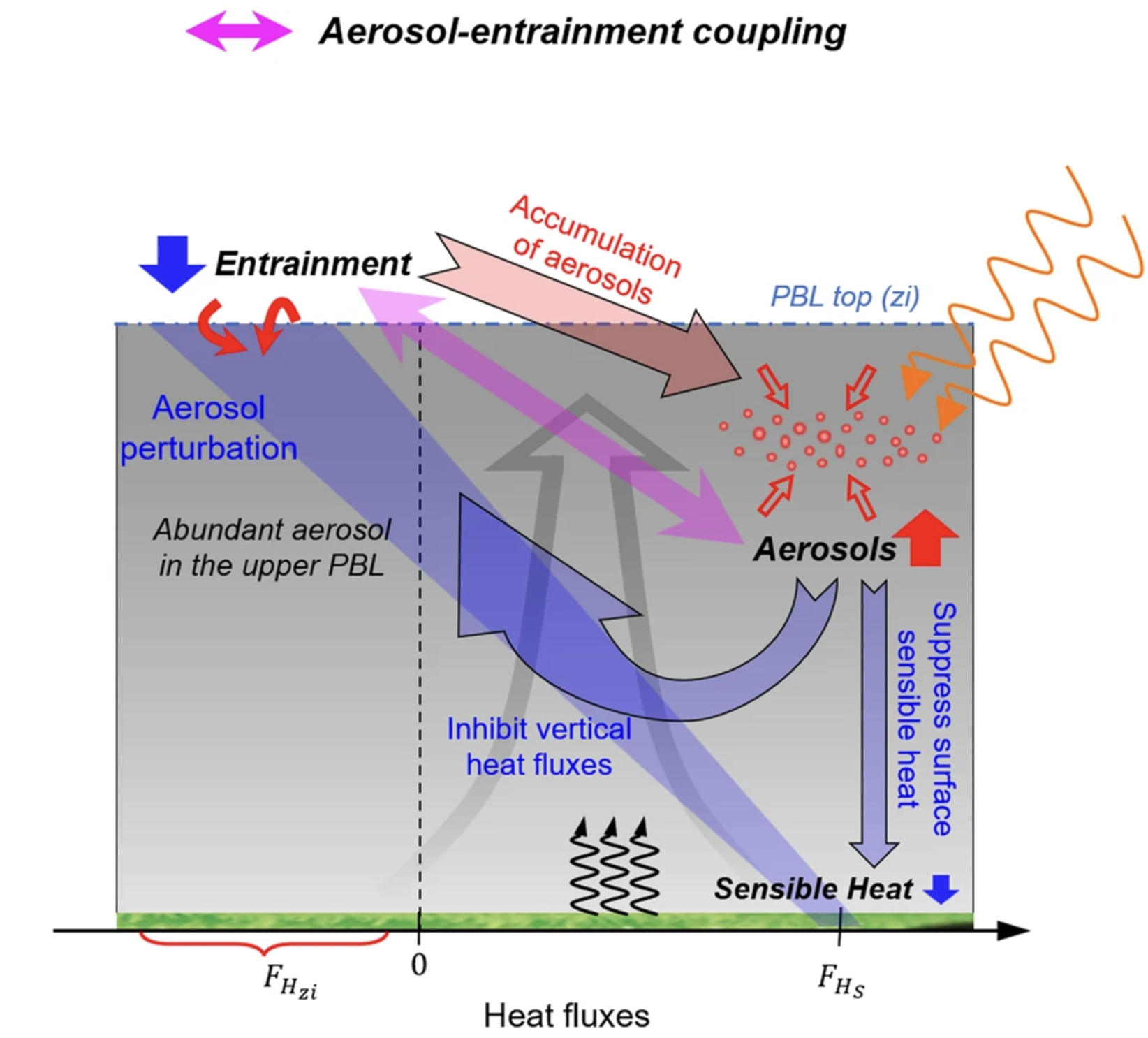Roles of Aerosol in Cloud-PBL-Surface System
Aerosols represent the second most significant contributor to climate change after greenhouse gases, yet their impact comes with substantial uncertainty due to their complex interactions within the integrated surface-PBL-cloud systems. Our research endeavors to unravel these complex mechanisms through a combination of advanced remote sensing techniques and modeling analysis. Specifically, our investigations focus on three key areas:
(1) Relationship Between Aerosol and PBL:
Exploring the relationships between PBL height and surface pollutants across China has unveiled a sensitive pattern of aerosol-PBL interactions (Su et al. 2018). Our investigations, leveraging space-borne lidar observations and 1600 surface sites, underscore the variable influence of topography and meteorological conditions on these interactions. In heavy polluted regions like the North China Plain, we observed a nonlinearly negative response of aerosols to PBL variations. Furthermore, such sensitive responses of aerosols to PBL revealed that the shallow PBL during the COVID-19 lockdown was likely a key player in dictating air poolution in North China. These analyses can help explain the high-profile haze event during the lockdown period (Su et al. 2020, GRL). This work advances our understanding of regional air pollution patterns and their driving factors.
(2) Critical Role of Aerosol Vertical Distribution:
Focusing on the critical role of aerosol vertical distributions, our studies reveal how these distributions modulate the PBL and entrainment processes. By categorizing aerosol structures into well-mixed, decreasing with height, and inverse structures, we identified distinct impacts on PBL development and atmospheric buoyancy. Particularly, the inverse aerosol structure with abundant absorbing aerosols can strengthen the aerosol-PBL interaction. It reveals the important roles of aerosol vertical distributions in aerosol climate effects (Su et al. 2020, ACP).
We further gain insight into the response of the entrainment process to aerosols. Depending on the vertical distribution of aerosols, aerosol heating effects can alter vertical heat fluxes, leading to a strong interaction between aerosols and the entrainment process in the upper PBL (see Figure). Such aerosol-entrainment coupling can inhibit PBL development and explains the greater sensitivity of observed entrainment rates to aerosols than traditional calculations. The notable impact of aerosols on the entrainment process raises holistic thinking about the dynamic framework of the boundary layer in a polluted atmosphere, which may have a significant bearing on the dispersion of air pollutants and the land-atmosphere coupling (Su et al. 2022).
(3) Aerosol Effects on Local Scale Convective System:
Our examination of the declining frequency of local-scale summertime precipitation over eastern China and the United States presents a compelling narrative on the impact of aerosols on local-scale convective systems (Guo and Su et al. 2017, 2019). The observed variations in precipitation events, coupled with notable trends in rain rate and aerosols, underscore the potential roles of aerosols in shaping local weather patterns (i.e., PBL coupled systems). This trend, observed across two continents with divergent aerosol trends, highlights aerosols' dual role in modulating local convections: enhancing precipitation under a clean environment but suppressing it when the environment becomes heavily polluted. These findings indicate the aerosol-cloud-precipitation interaction is tied with PBL processes, holding profound implications for how the local convections interact with human activities.

Related Papers:
- Su, T. et al. 2022. Aerosol-boundary layer interaction modulated entrainment process. npj Climate and Atmospheric Science. [Link] (ASR Highlight)
- Su, T. et al. 2020. The significant impact of aerosols vertical structure on lower-atmosphere stability and its critical role in aerosol-PBL interaction. Atmos. Chem. Phys. [Link] (ASR Highlight)
- Su, T. et al. 2020. Abnormally shallow boundary layer associated with severe air pollution during the COVID‐19 lockdown in China. Geophysical Research Letters. [Link]
- Su, T., Li, Z., Kahn, R., 2018. Relationships between the planetary boundary layer height and surface pollutants derived from lidar observations over China: regional pattern and influencing factors. Atmos. Chem. Phys. [Link] (UMD Highlight)
- Su, T. et al., 2017. An intercomparison of long-term planetary boundary layer heights retrieved from CALIPSO, ground-based lidar, and radiosonde measurements over Hong Kong. J. Geophys. Res. Atmos. [Link]
- Guo, J. +*, Su, T.+* et al. 2019. Declining Summertime Local‐Scale Precipitation Frequency Over China and the United States, 1981-2012: The Disparate Roles of Aerosols. Geophys. Res. Lett. (*corresponding author; +co-first author) [Link]
- Guo, J.*, Su, T.*, et al. 2017. Declining frequency of summertime local-scale precipitation over eastern China from 1970 to 2010 and its potential link to aerosols. Geophys. Res. Lett. (*corresponding author) [Link]